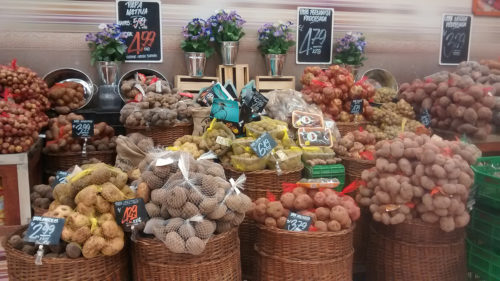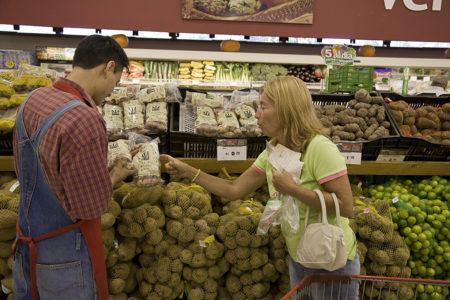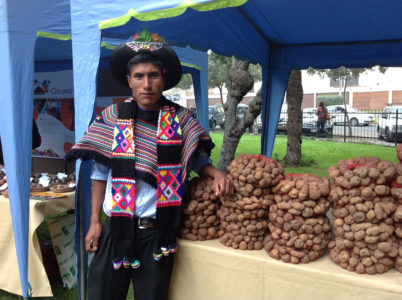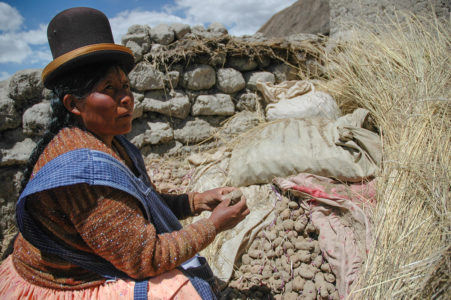
A pathway to markets, the Participatory Market Chain Approach
What began in 2002, to facilitate market access for smallholder native potato farmers in Peru has blossomed into a market inclusion approach now used in Bolivia, Colombia, Uganda, and Indonesia. Known as the Participatory Market Chain Approach (PMCA), it aims to foster trust and collaboration between the different actors in a value chain and use innovation to spur new opportunities.
Agricultural economist, Miguel Ordinola, shares how pro-poor value chain development can lead to innovation, growth, and income for all involved.
PMCA has been used to develop markets for native potatoes, coffee, even hot peppers, how do you identify which crops will work?
You have to start with a concrete market opportunity; it won’t work if you only focus on supply. In the case of Peru, studies have identified three market segments in the potato sector, two of which relate to native potatoes, which are produced precisely in the areas where poverty is most pronounced. With currently more than 3,000 varieties, Peru’s native potato biodiversity is the largest in the world. Our focus has been aimed at both farmers and the general public understanding that this product has value in its own right, with a rich history and important role in the Peruvian culinary scene.
Lima (Peru) is a big city, with a large migrant population. Market studies showed that Limeños remembered their parents and grandparents talking about colored potatoes. When they then began to see those same native potatoes in today’s supermarkets, it triggered a sense of nostalgia, and the commercial concept took off. Gastronomy has also helped us a lot, by giving native potatoes the visibility needed to awaken a dormant demand that was already there.

PMCA includes stakeholders from across the value chain, why is this important and how does it help strengthen the value chain?
First, we do market studies to identify the different stakeholders. If you look at the market chain in its entirety, it includes wholesalers, researchers, end consumers, supermarkets, processors, chefs and smallholder farmers. They are all actors in the chain, but they don’t necessarily know anything about each other. We wanted to bring them together, so they could get to know one another and identify with one another. For this, we used tools, such as theater, with researchers taking on the role of different actors in the market. Maybe a scene illustrates a wholesaler rejecting a product for poor quality, or a farmer rejects an offer because the price is too low. The real value chain actors can see themselves reflected in these situations and a level of trust is developed. Being able to relate to and understanding the people you are dealing with generates more direct access and connection, making it easier to identify potential business opportunities and foster improved cooperation.
Markets, in general, are often risk- adverse, how can organizations persuade companies to take a chance on new products?
Before native potato chips existed, the question was: can we make chips from native potatoes? The different market stakeholders always want to see evidence that an idea will work. They want a tangible product. We researched to see whether it was possible to process native potato to make chips. Tests were carried out to determine which potatoes would fry better, and 300 different varieties were tried out with varying qualities of oil, processing protocols, and shelf life. Prototypes were generated to demonstrate that native potato could be successfully processed for a specific, concrete product. I remember that they started off selling at the airport as a “souvenir” for tourists to take home with them and the product was very well received.
Once you have concrete evidence that a market exists, that initial experience encourages others to develop their own innovative products. Innovation is a public good that anyone can use and recreate. For example, over time we began to see products with commercial concepts linked to local Peruvian dishes or with an ingredient typical of a particular region and other products that were certified organic; things that we didn’t even think about in the beginning. We started with two brands, and now there are 12 that are using native potatoes in products for both the national and international markets. The growing demand for native potatoes is benefitting the small farmer who now has greater possibilities to generate income.

How does including the voice of the smallholder farmer benefit the entire value chain?
The voice of the smallholder farmer ensures a more equitable distribution of benefits and consequently increased business sustainability. They become the main spokesperson for the quality of their product. The farmers themselves identify and ask for the improved technology they need to guarantee the quality of the final product. For example, at the start of the project, small native potato farmers suffered from post-harvest losses. When they started to harvest more volume, the potatoes were coming to market and after a few days were beginning to sprout (which is a natural process, but unacceptable to an end consumer) and consumers did not want to buy. Post-harvest technologies were tested to increase the shelf life of the product so that the producer did not lose the opportunities in these new expanding markets.

One of the challenges of working with smallholder farmers is that they produce in small quantities. How does PMCA help overcome this hurdle?
One of the key issues ensuring efficient market inclusion for smallholder farmers to group together. Coordination and association with other producers give them the opportunity to produce on the larger scale needed to supply the market. It also gives them more orderly and efficient access to the technologies they need (better seed quality and enhanced pest and disease control). For example, a smallholder may apply pest control practices, but if a neighbor does not do so, these types of problems that affect acceptance in the market will continue. As a group, farmers can also become emissaries for the knowledge, conservation, and valuation of their biodiversity, which is an important economic asset for them.
How do you ensure the sustainability of an intervention?
Sustainability comes first and foremost with the permanence and expansion of markets (a sustained demand). We need to generate and apply new concepts of commercial differentiation. We started with exotic colors, shapes, and flavors. Now we have to develop a new focus on nutrition and health (for example the micronutrient content and how we convert that into a commercial concept). Markets need to keep expanding and innovating.
As far as small farmers are concerned, as long as these markets remain strong, they will continue to innovate on their small plots and preserve and value the biodiversity of their crop. What we have to ensure is that they get the new technologies and business management criteria they need to access markets efficiently. Thanks to native potato they can generate income for the wellbeing of their families.
You can sense the pride among farmers. Now that their potatoes, which nobody used to want, are so well loved, both at home and abroad.
Miguel Ordinola is an agricultural economist at the International Potato Center. He oversees potato projects in Latin America and Peru.
